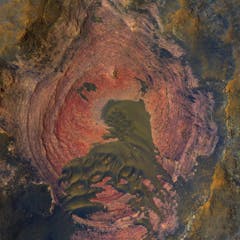
Todos os artigos de NASA
Exibindo 241 - 260 de 482 artigos

By understanding how bushfire maps are created, and what their features represent, you can get better at spotting fake ones.

We pulled four before-and-after NASA satellite images and asked bushfire researcher Grant Williamson to reflect on the story they tell.

Scientists can’t expect the unexpected if they’re not open-minded about how their theories might be wrong.

Sometimes it is difficult to take a photograph of an exoplanet because the star illuminating it is too bright. Now there is a new ‘deluminator’ telescope that can block out the extra light.

Collecting samples from Mars and brining them back to Earth will be a hugely complicated task, but it may be our best bet of finding alien life.

Beyond the outer edge of the Solar System, mysterious, unknown worlds await by the thousands. Astronomers can now finally find them and explore them - but will we find another Earth?

NASA has released a sound recording from Mars. So what do these literally otherworldly sounds tell us about the processes at play inside the red planet?

A giant exomoon hundreds of times the size of Earth is revealing secrets about how giant planets like Jupiter and Saturn formed. They might also help astronomers find planets where life may thrive.

From solar sail-powered spacecraft, to laser communications, to asteroid detection systems, there is no shortage of Australian ideas and expertise to help NASA explore the Moon and Mars.

How is NASA preparing astronauts for high-stress living on the Moon? Turns out the answer is by living in undersea bases just off the coast of Florida in a lab known as Aquarius Reef Base.

It’s established Mars was once a planet with surface-level water. So with multiple MARS missions starting next year, the key to seeking out martian life may instead lie in the contents of its ‘dust’.

NASA’s Europa Clipper mission just got the green light - here’s what it could achieve.

This hot, acidic neighbor with its surface veiled in thick clouds hasn’t benefited from the attention showered on Mars and the Moon. But Venus may offer insights into the fate of the Earth.

India’s Moon shot isn’t just about prestige. As launch costs fall, the space economy is poised to boom. A lengthening list of nations is eyeing the sky.

Some climate scientists have spoken out about the dangers of climate change. But a new study shows those voices may not be very influential.

Space missions are dangerous. But when it comes to long missions, radiation may be the greatest threat to astronauts’ health.

CC BY-ND30,8 MB (download)
The fifth episode of the To the moon and beyond podcast series explores where we will be travelling in 2069.

The future of lunar exploration and space travel will be possible only through advances in robotic design and implementation.

When Neil Armstrong stepped on to the Moon 50 years ago this month, Australians saw the images first. Australia even defied bad weather to bring the historic images to the world.

Just 12 people stepped on the Moon during the Apollo missions, but they left more than just footprints. It’s a legacy that needs protecting from damage by any future Moon missions.
